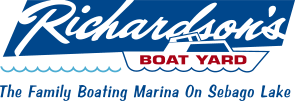Navigating Shallow Water
 You aren’t always in water so deep that you can’t see the bottom when you’re boating. Sometimes, you’ll want to trawl closer to shore to look for fish that swim along the riverbank or coast. Other times, you may need to make your way through a narrow inlet bordered by treacherous sandbars to reach open water again. Either way, you’ll need to know how to navigate shallow water.
You aren’t always in water so deep that you can’t see the bottom when you’re boating. Sometimes, you’ll want to trawl closer to shore to look for fish that swim along the riverbank or coast. Other times, you may need to make your way through a narrow inlet bordered by treacherous sandbars to reach open water again. Either way, you’ll need to know how to navigate shallow water.
This guide by Richardson’s Boat Yard should help you become more confident when navigating shallow water. We’re your local Bennington boat dealer, carrying pontoon boats for sale near Portland, Maine. We have locations in the cities of Windham and Standish to best serve you. Bring us any navigational questions you might have!
How To Prepare
Any successful marine adventure begins with sufficient planning to ensure everything goes off without a hitch. One of the best ways to prepare yourself for any kind of boating is to take a course by the United States Coast Guard, which will give you tips for handling your craft in any type of weather and dealing with emergencies or issues as they arise. This can help you to be more confident, particularly when navigating in unfamiliar areas.
Secondly, you’ll want to make sure you can read the depths so you can adjust your approach as needed. Use plastic-coated prints or electronic depth charts to familiarize yourself with the lake or bay you’re boating in so you know where islands and sandbars are in advance.
Finally, you’ll want to check the weather forecast in advance of setting out. Any hint of a storm means you should reschedule your trip for a clearer day. Your boat won’t easily handle rough conditions and could be blown aground in the shallows. Checking the local tide cycles will also help you to know where it’s safe to coast.
Watching The Depth
As you coast through the water, you should remain aware of your vessel’s draft. “Draft” refers to how high water comes up the sides of your boat, so you want to remain in water that’s deeper than that to avoid running aground in the shallows. Your boat may have a planing hull that sits lower in the water which can shift your draft when you get up to the right speed or “on plane.” This can let you glide through slightly shallower water than you might otherwise be able to do. Be vigilant as you do this and don’t go too fast so you can watch for and react to obstacles.
Something else you’ll want to remain aware of is the water color, which can indicate depth at a glance. If you see a sudden shift in coloration, this indicates a shift in depth as well. Brown or white water often means the bottom is very close to the surface. Uneven areas or eddies also indicate shallow regions. Clear, blue or green water generally indicates that the water is sufficiently deep enough that your boat shouldn’t run aground. Use this information along with your charts of an area to figure out how deep you are at any given time.
Driving Carefully
Your boat’s operation is not wholly unlike that of a passenger vehicle. You need to remain alert when you’re at the controls and always focus ahead to scan for obstacles in your path. Go at a reasonable speed, particularly when you’re not certain of the depth in an area. Remain sober and make sure you’re well-rested when operating your craft so that you have your wits about you and can react quickly in an emergency. Leave space between yourself and other crafts in the water. Ensure all your passengers are briefed on safety rules and wearing life jackets, too.
We hope our guide to navigation helps you explore the shallows safely, whether you’re on a pleasure cruise or seeking out fish that swim near to shore. Looking for used boats for sale in Maine? Visit one of our dealership locations in Windham or Standish to check out our inventory of marine crafts. Richardson’s Boat Yard also proudly serves the cities of Portland and Auburn.
